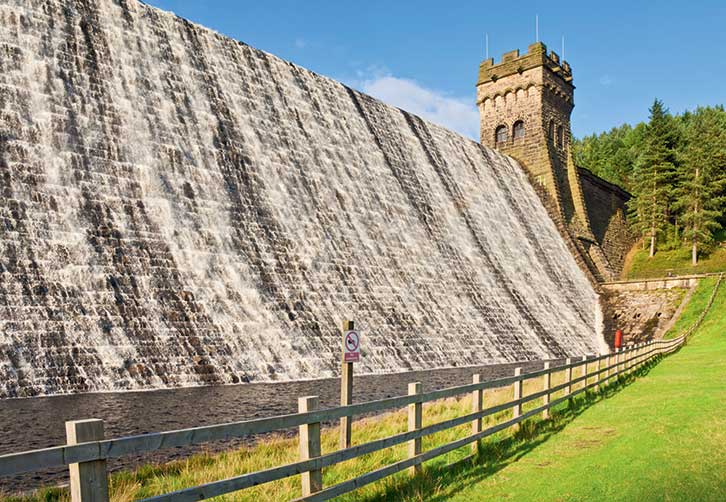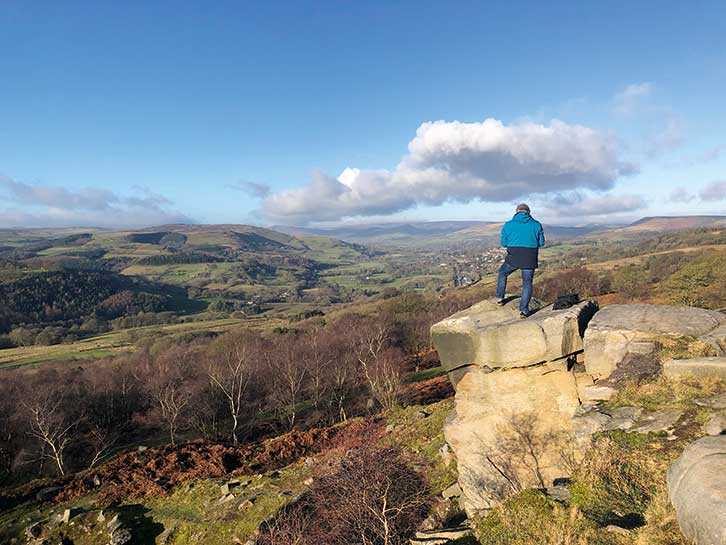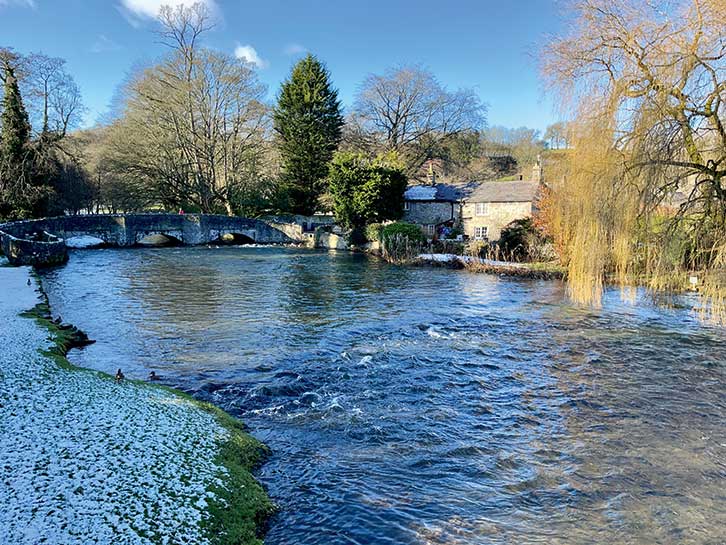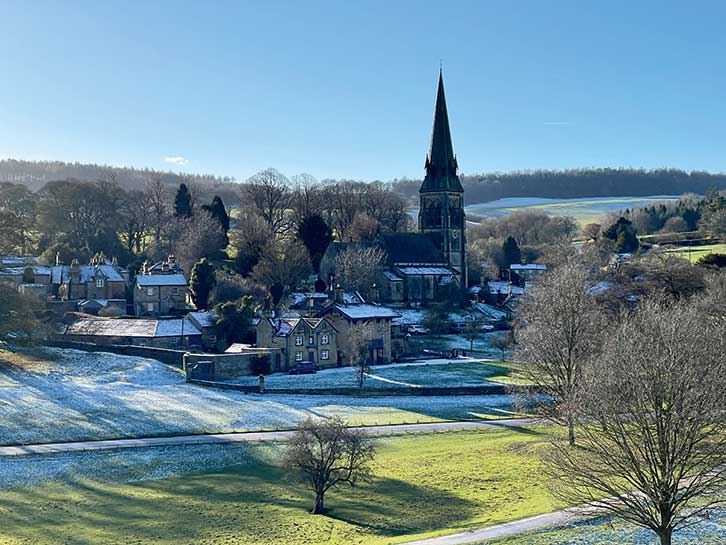We are fortunate enough to have glorious Chatsworth House only half an hour or so from home. But while Kay and I are often in the area, visiting relatives in nearby Baslow and a bit farther afield in Hope Valley, I am sorry to say that we rather take Chatsworth for granted when we are passing by on our travels.
However, you don’t need to travel great distances to find the best motorhome sites and regions for a tour.
The CAMC has a splendid site in the grounds of Chatsworth Park. It’s been a few years since we stayed there, but to blow away the January blues, we decided to book in for a few days last year.
We arrived in the afternoon and were soon set up – a good thing too, because shortly afterwards the heavens opened and the winds picked up.
The forecast for the first couple of days wasn’t particularly great, but what the heck, we were here to relax and enjoy a leisurely stroll as and when we could, not rush about.
The following morning, it was still grey and showery, so we decided to visit the Chatsworth Farm Shop, in the nearby village of Pilsley.
Although as the crow flies, the shop is actually less than a mile away, there is no direct pathway and there’s the River Derwent to cross, as well, so for us, a drive was going to be necessary.

It’s well worth it, though – and there’s a good-sized car park with lots of spaces. The wares are all first class, and considering where you are, they are pretty good value, too. We have even been known to make the journey from home just to enjoy one of their excellent breakfasts.
Most of the produce available here is sourced from the Chatsworth estate, and unsurprisingly, the café has such a great reputation, you might find that at times, you’ll have to wait for a while before getting a table.
After having our coffee ‘fix’, it was time for a wander around the farm shop. Again, the produce is first rate, although the prices are not bargain basement. But we don’t mind paying a bit extra for the superb quality.
Strolling to the great house
As the rain had abated by the time we got back to the campervan campsite, after lunch, we decided to take a walk to the house (aka the shop!).
The CAMC site is wonderfully located in the old Walled Garden on the estate. One side backs on to the charming scenery of the River Derwent, which we could see over the wall from our pitch.
On arrival at the campsite, you are given a key to the ‘secret door’ in the wall, which brings you directly into Chatsworth Park, with the house a short walk away.
Building of the original Chatsworth House began in 1553, for Bess of Hardwick (famed for nearby Hardwick Hall, and a Cavendish by marriage). She died in 1608 and
left the house to her eldest son, who sold it to his brother, William, 1st Earl of Devonshire.
The house we see today was completely rebuilt in the 17th century, with formal gardens designed by Capability Brown. Then in the 1980s, the Chatsworth House Trust took over the property. To this day, Chatsworth House remains the residence of the Dukes of Devonshire.
In the beautiful formal gardens, a focal point is the Emperor Fountain, which is quite a sight when it’s in operation. It is gravity fed from the Emperor Lake at the top of the hill behind the house, and on record as reaching up to 300ft.
Also on the summit of the nearby hill is the Hunting Tower, which was built in 1570 as an observation point for the deer park. It’s now a rather fabulous holiday let.

It’s been years since I walked up to the Hunting Tower or the Emperor Lake, so I left Kay in the shop and went for it. Halfway up the very steep steps, I must admit I wondered whether I was doing the right thing! This is not a walk for the less able. But despite the dullness of the day, the view from the top was worth it.

Then thankfully, Kay was just putting on the kettle as I got back to the campsite.
Visiting Derwent Valley dams
Although next morning brought more grey skies, at least it wasn’t raining. One of Kay’s sisters had let us know that the Derwent Valley dams (Ladybower, Derwent and Howden) were now overflowing, so we drove to the Upper Derwent Visitor Centre (the car park is suitable for small- to medium-sized motorhomes) to take a look at the water gushing over the Derwent Dam wall – quite a sight.
Derwent is the middle of the three reservoirs, built to supply water for the East Midlands and Sheffield. Construction started in the early 20th century, and two villages, Derwent and Ashopton, were abandoned during their building.
When the water levels are very low, you can still see the foundations of many old buildings. Although Derwent church was destroyed in the making of the dam, its tower and spire remained. These days, there are some eery old photographs showing the spire sticking out of the water, but for safety reasons, it too was blown up, in 1947. Apparently, people had taken to swimming out to the spire and climbing it as a challenge!
Derwent Dam is probably best known for being the practice run for the famous 1943 Dambusters raid in WWII, and the UK’s last remaining airworthy Avro Lancaster bomber is sometimes to be seen flying overhead.

Stop to enjoy the view
By the time we left Derwent, the skies had cleared, so we decided to drive back to the campsite via Hope Valley and the Surprise View, on the Sheffield side of the village of Hathersage on the A6187.

The surprise is that when driving from the Sheffield direction, you turn a corner in the road and are met (on a clear day) with a splendid view of the Hope Valley. There’s a car park – which can get busy – before you reach the corner, so it’s worth parking and walking, to savour the view.
We awoke to a clear day the following morning, and a very sharp frost, which was fantastic news as we planned another walk. We made the short drive to Curbar Gap car park (free to National Trust and RSPB members), and then set off walking along Curbar Edge.
We found not only frost, but also a sprinkling of snow. The views were stunning, and we could see Chatsworth in the distance. Just about every step we took afforded a new vista and it was hard to take it all in, even though we know the trail. Rather than taking one of the circular routes, we turned back on ourselves, to continue enjoying those views. Back at the car park, we crossed the road and walked towards Baslow Edge.
Our path there wasn’t along the Edge, as it had been on Curbar, because we wanted to walk past the Eagle Rock, a strange, huge boulder sitting in the middle of nowhere.
You might think the rock gets its name from its appearance (I certainly struggled to find any resemblance to a bird of prey), but it is thought to derive from the Celtic god Aigle, who was fond of throwing rocks around in the countryside.
Continuing on the path, we came to Wellington’s Monument, a large stone cross erected in 1866 by a local man, Dr Wrench, to celebrate the 1815 victory at Waterloo. Then our walk back to the car took us along the Edge, once again with the accompanying views.
For the more energetic among you, it is possible to walk to Baslow/Curbar Edges from the campsite, with no need to walk along roads for any distance. Another time, perhaps!
Picture-book villages
Rather than driving straight back to the site from Curbar Edge, we made a brief detour to Ashford-in-the-Water, a charming village not far from Bakewell; we parked (considerately) beside the road. The ancient bridge over the River Wye here is thought to be the most photographed bridge in Britain.

Ashford is a classically pretty Derbyshire village, and the Riverside House Hotel is a special place for Kay and me – it’s where we held our wedding breakfast (quite a few years ago, now!).
Next morning, we opened the blinds to find the ’van surrounded by thick mist. Our plan had been to visit nearby Bakewell and then walk part of the Monsal Trail, from Hassop Station. We’ve walked and cycled this trail many times from Hassop to Miller’s Dale, passing through old tunnels and crossing the Monsal Head Viaduct, but we could not see the point today, because we wouldn’t see much. Instead, we decided to visit Bakewell.
Puddings and tarts
As well as being a thriving market town, Bakewell is most famous for its Pudding (and its latter-day Tart), so no trip to this charming spot would be complete without visiting The Old Original Bakewell Pudding Shop, now would it?

The Pudding came about by accident over 150 years ago, when local woman Ann Greaves forgot to stir her egg mixture into some pastry, instead spreading it on top of jam in the pastry case. Apparently, the resulting dessert went down a storm, and thus the Bakewell Pudding was born – but one ingredient still remains a secret!
For parking in Bakewell, try the Agricultural Business Centre Car Park Pay And Display.
Out of curiosity, after leaving Bakewell, we decided to drive to Monsal Head, and halfway up, we left the mist and emerged into bright sunshine. But looking down into the valley,
we struggled to see the viaduct, because the mist was still swirling below.
Thankfully, our final day was clear, so after a leisurely morning, we walked to Chatsworth House. We didn’t go inside the house this time, because we visited recently to see the spectacular Christmas decorations – they are well worth seeing.
Surrounded by history
Passing by the house, we took the footpath to the village of Edensor (pronounced ‘Enza’). The original settlement was demolished by the 6th Duke of Devonshire, as it spoiled his view! He had it rebuilt out of sight – today, it’s a hotch-potch, everything from mock Tudor to Swiss chalet.
Several members of the Cavendish family are buried in Edensor churchyard, as is Kathleen Kennedy, a sister of the late US President John F Kennedy. She was married to William Cavendish, who was killed in action during WWII.

Deborah, one of the famous Mitford sisters, who became Dowager Duchess of Devonshire following the death of her husband, the 11th Duke, retired to the village and was often seen out and about on the estate, until her death in 2014 at the age of 94.
We returned to the campsite to spend the final evening of a very enjoyable break simply relaxing. Having such a wonderful destination right on our doorstep can at times make us take the beauty of the place rather for granted, but one of the many pleasures of a motorhome trip is that you can be part of that historic location, for a while.
If you’re looking for some more touring inspiration, take a look at how Susan and Ro Taylor got on as they embarked upon a tour of Stratford-upon-Avon. You can also find out how Peter Rosenthal got on as he set about exploring the Tissington Trail, a pretty part of Derbyshire.
Planning a tour to Chatsworth
Way to go
From the east, turn left off the A619 in Baslow, 140m past the Cavendish Hotel into the site entrance.
Note that the driveway is a private single-track road, with no parking or waiting permitted.
From the west, at the Baslow roundabout, take the A619 towards Chesterfield, then the first right turn (just after the cricket field, within 100m of the roundabout) into the campsite entrance. Bear in mind that the bridge there has a 5t weight limit.
Where we stayed
Chatsworth Park CAMC Site
Baslow, Bakewell, Derbyshire DE45 1PN, 01246 582 226
- Open: All year
- Pitches: 120 (94 hardstanding)
The campsite is within the old Walled Garden on the Chatsworth Estate, with the house a short walk away. All pitches are clearly marked, and the site is immaculate. Pitches are mainly hardstanding and all have electric hook-up.
Find out more
- Chatsworth House
- Derwent Valley dams
- Curbar Edge
- Baslow Edge
- Monsal Trail
- The Old Original Bakewell Pudding Shop
- Motorhome parking
If you’ve enjoyed reading this article, why not get the latest news, reviews and features delivered direct to your door or inbox every month. Take advantage of our brilliant Practical Motorhome magazine SUBSCRIBERS’ OFFER and SIGN UP TO OUR NEWSLETTER for regular weekly updates on all things motorhome related.

